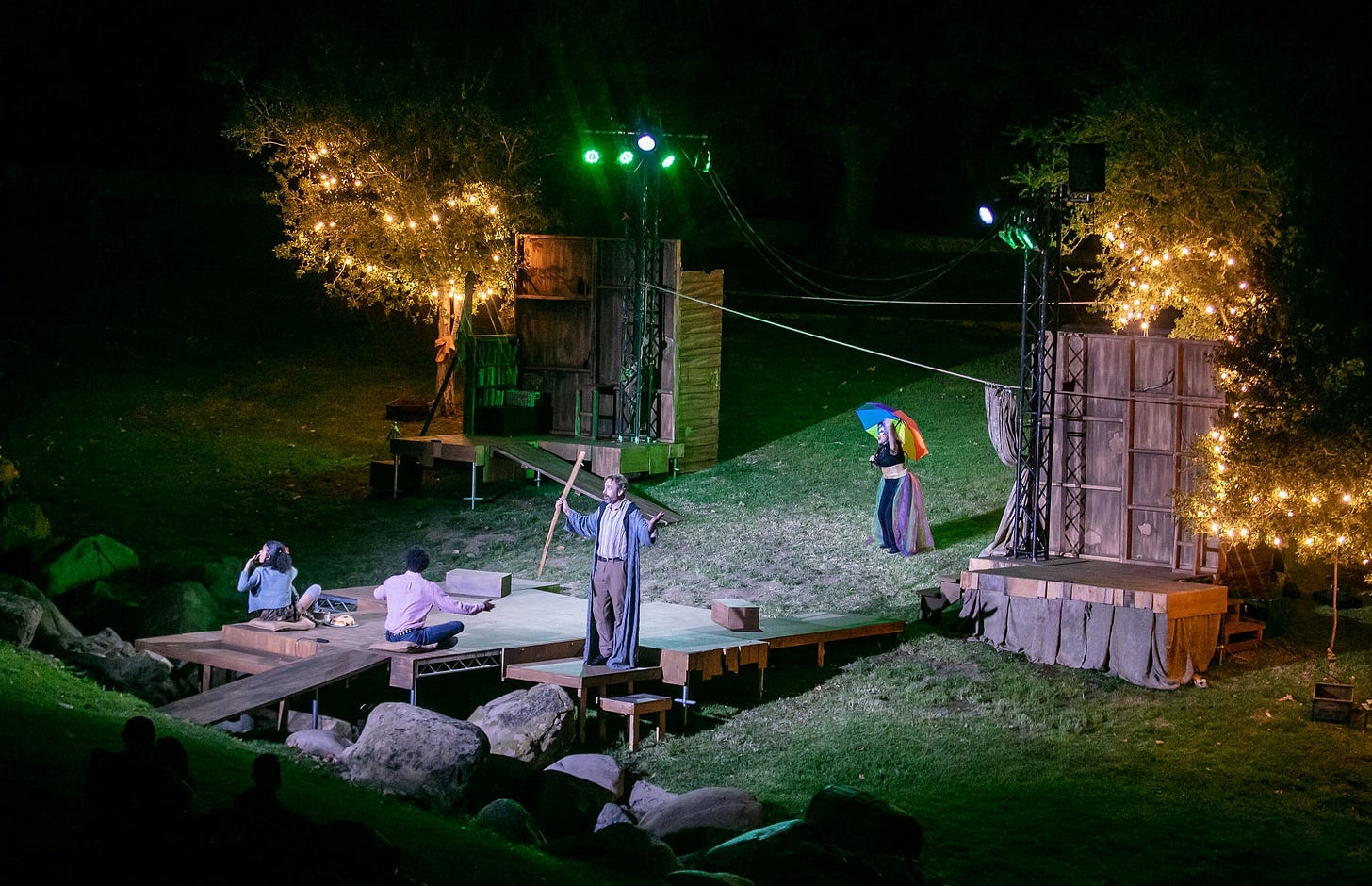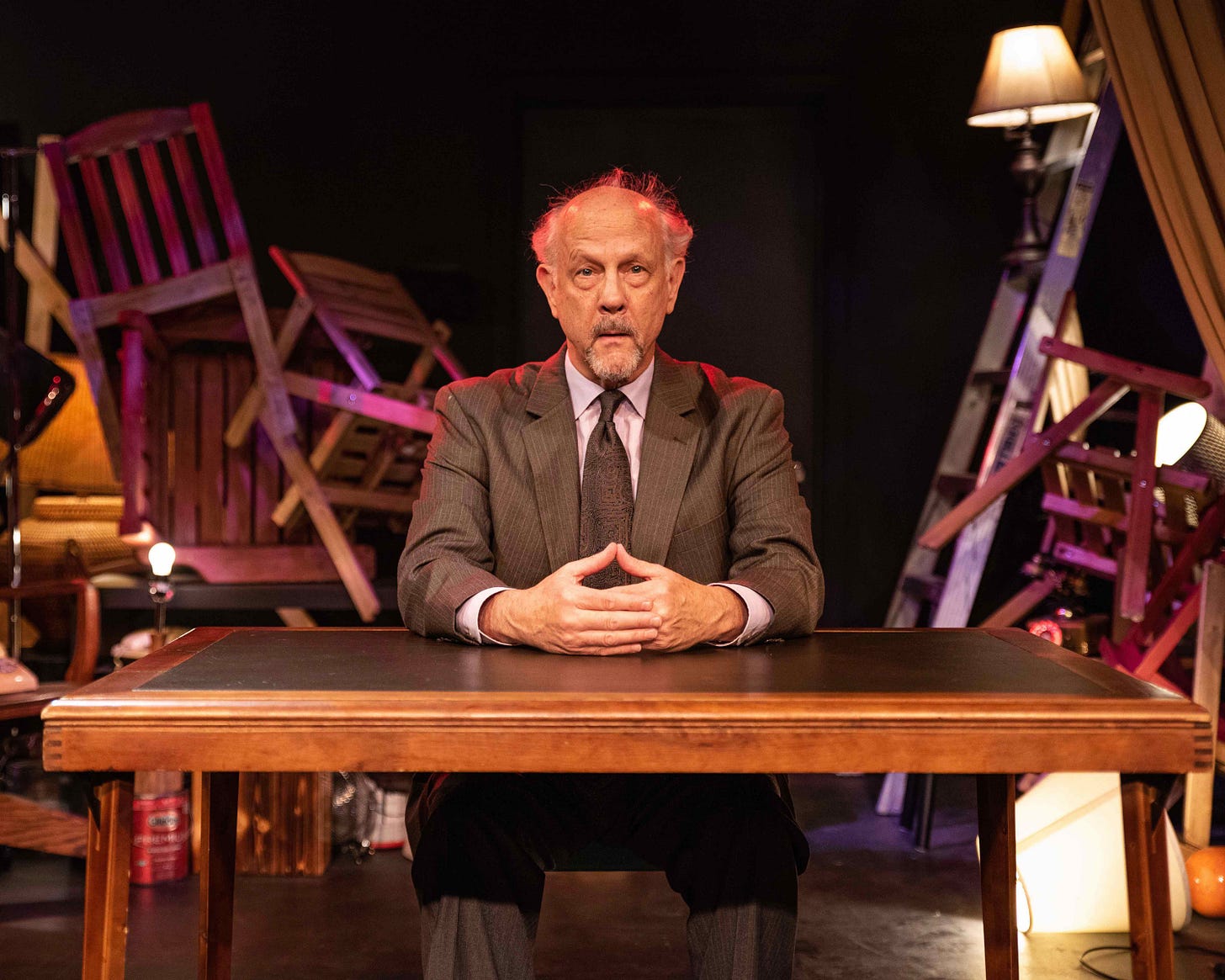A tempest before 'The Tempest'. A tale of two towns.
Vandals attack ISC. Fillmore as Grover's Corners. Audiences, take your bows.
The show must go on?
Surely this is the least accurate cliché in the American theater – considering that thousands of shows did not go on as previously scheduled, within the past 18 months of COVID.
Nonetheless, in a stirring demonstration of the continuing strength of this imperfect vow, Independent Shakespeare Company’s official opening of an alfresco “Tempest” , staged by Melissa Chalsma, did indeed occur in Griffith Park last Saturday.
This happened after an all-day emergency effort to fix the set and lighting, which had been damaged by vandals during the previous night.
First, let’s review the location. This year ISC moved away from its usual spot -- on the east end of a large meadow in the Old Zoo section of the park. In pre-COVID years, that area accommodated crowds numbering as many as 2000, who turned up for the free ISC productions. But much of that meadow is now a construction site for the company’s first permanent stage, which should be ready for next summer.
Instead, as a temporary measure ISC moved westward this year, over a slight rise, to a small dell, where the audience sits on the gently inclined south side of a normally dry stream bed. The actors perform on a makeshift stage over the not-so-babbling brook and on its bank to the north. Because of COVID, the nightly audience has been restricted to 250, and reservations are required. Each pod of spectators is somewhat distanced from other pods.
This site is more secluded than its predecessor. Even though we’re on inland terrain, the dell is an appropriate stand-in for the wild island of “The Tempest,” in which urban castaways confront forces of nature as well as each other. But no one expected the real-life despoilers who assaulted the ISC set during the night.
Last Saturday morning around 9, “when I hadn’t even had a cup of tea,” David Melville got the news from park personnel and a hiker friend via phone calls and texts that ISC’s equipment in the dell had been defiled. It was a shock for Melville, who is not only ISC’s managing director but who also plays the leading role of Prospero in “Tempest.”
On the way to the site from his nearby home, he optimistically hoped that it was merely a case of advanced tagging and that it might be “easy to fix,” he recalls. But when he arrived, he quickly realized that “it was my image of the worst it could be.”
A bolted lighting tower had been completely toppled. Flats were pulled off their backing with the facing ripped off. Cut cables, smashed lights and a speaker greeted Melville. Yes, some graffiti had been left, but it consisted of indecipherable “squiggles.”
The replacement of everything that was damaged would cost $15,000, but ISC “had to spend $2500 there and then,” Melville says, so that the show could go on a few hours later.
Many people pitched in to the task at hand. Not only cast and crew members, but others – including the father of an intern and the father of the actress playing Miranda -- showed up to help, sometimes bearing tools. Melville himself employed soldering skills that “I picked up during the pandemic.”
Although there were wildlife cameras in the area, there were no 24-hour cameras focused on the stage when the vandals attacked. That has now changed, Melville says.
Everyone worked through the day, which led soon into the announced 7 pm curtain time – when everyone had to switch gears into their usual roles on or off the stage. Melville says the experience was “galvanizing. There was no time to worry.” However, he says he knows that the quality of “the sound was not great” because the speakers weren’t properly equalized.
In Melville’s remarks to the audience after the performance, he described the vandals as “little bastards.” But then, in the spirit of Prospero at the end of “The Tempest,” he acknowledged that the play is about reconciliation and forgiveness, so he pledged “to forgive the little bastards.”
Talk of the Towns
The Ventura County town of Fillmore calls itself “the last best small town in Southern California.”
Playwright John Guerra, perhaps noticing the use of “town” in this motto, decided to adapt elements of Thornton Wilder’s celebrated “Our Town” -- which is set mostly in the fictional Grover’s Corners, New Hampshire during the first decade of the 20th century -- to characters who live in Fillmore in the first decade of the 21st century.
The result, Guerra’s “The Last, Best Small Town,” is receiving its premiere this summer at Topanga’s Theatricum Botanicum, in Los Angeles County, about 25 miles southeast of Fillmore (as the crow flies).
As in “Our Town,” Guerra’s play has a meta-theatrical narrator – here it’s “the Playwright” (Leandro Cano) instead of “the Stage Manager.” Other similarities include two high schoolers who realize that they’re in love and even want to marry, and a dad who edits the local newspaper.

The young man in Guerra’s couple hesitates about going off to college, but this almost seems like a nod to Wilder’s corresponding character instead of a choice that Guerra’s character would plausibly make on his own. A drunk hovers around the edges – although he doesn’t direct the church choir, as did Wilder’s Simon Stimson (a part I stumbled through in a high-school production).
Many differences between the two plays are also apparent. Wilder’s priorities were elemental, evergreen themes – which might begin to explain why his play has endured through eight decades. Guerra, by contrast, was thinking about the lead-up to the Great Recession and its aftermath, as well as the relationship between a Latinx family and their white side-by-side neighbors (Guerra himself is the son of one white parent and one Latinx parent). These are worthy topics, but is an updated version of “Our Town” the best way to dramatize them?
Director Ellen Geer, who runs the primarily classical Theatricum, was probably drawn to the concept of a play set in this area but modeled on an American classic. The linkage is momentarily fascinating, but at times it gets in the way of Guerra’s contemporary stories -- while nevertheless imposing undue expectations on his play for the many members of the audience who know and love Wilder’s script.
The poignance of Guerra’s play doesn’t come close to that of “Our Town.” The only character whose death is noted in “The Last, Best Small Town” dies far from Fillmore, and he never appears on stage in either his life or his death. In contrast, several previously living characters are depicted in the afterlife in Wilder’s third act, including the central character, Emily.
By the way, Guerra grew up in Santa Barbara County’s Carpinteria, not Fillmore, but he has often traveled through Fillmore. Carpinteria is also a small town, with about 2000 fewer people than Fillmore. But the motto on Carpinteria’s website – “Home of the World’s Safest Beach” – probably didn’t evoke the same qualities that Guerra wanted in his play’s title.
If only Wilder had written a play called “Our Beach”…
Audiences, feel the burn
Two current productions emphasize the power of the feelings that can arise from being side by side with other real people in a theater. Presumably their creators want to remind their audiences that in-person theater has qualities that are lacking in Zoom theater or on screens of any kind.
In John Kolvenbach’s “Stand Up If You’re Here Tonight,” the primary character warms up the audience with exercises such as the one described in the title. And he describes his goal of blending audience and show into a “shmeer…
…Not that you will be warmed up or that I will, but the thing between us. Two pots are on a stove and neither boils but you could make pasta in the space in between.”
This is an apt observation, but I also sensed from this relatively brief performance that the exhortations of this character (Jim Ortlieb) veer somewhat toward parody -- of a motivational speaker who can’t stop thinking about his mother. Every night he imagines that his mom is in the audience. Whatever the intent, “Stand Up” is amusing as it engages our bodies as well as our brains and funny bones.
Because this production is housed within one of the smallest spaces in the Atwater Village Theatre complex, don’t forget to bring not only masks but also your vaccination cards – they’ll be checked at the door. Directed by the playwright, “Stand Up” is a Vs. Theatre production in association with Circle X Theatre.
Vaccination cards are also checked at the door of “Welcome to the Neighborhood” in Hollywood, even though it takes place almost entirely outside, on the front courtyard of an acting studio.
“Welcome” is set at a neighborhood barbecue in Hollywood in 1953. The fictional party is a chance to socialize after 15 months in which residents were supposedly confined to underground bunkers, following the release of dangerous radiation throughout the Los Angeles area during an offshore missile test.
The extent of audience participation in “Welcome” easily tops anything in “Stand Up.” In “Welcome,” I was on my feet throughout the entire show as I circulated and chatted with costumed actors playing fellow “neighbors” as well as other audience members.
Scott Golden’s script, abetted by improv, explores several subplots simultaneously in different parts of the space. As at many social events, any one spectator can easily get the feeling of missing developments that occur 10 feet away. It’s fun on one level, but confusing and frustrating on another.
The costume designers and most of the actors do a good job of re-creating 1953, but I can’t say the same for the set. At one point I was guided into a bathroom that looked too much like a public WC in the 21st century. If 2Cents Theatre Company produces this again, finding a vintage-1953 house and yard should be high on the priority list.



